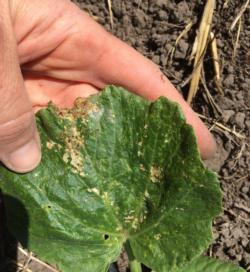Options for Pesticide Use in Organic Systems - 12/13/18 (WEBINAR)

On this page, you will also find the slides for each individual presentation, along with many additional resources for choosing, handling, and reporting pesticide use on a certified organic farm or ranch.
Note: The list of materials approved for use by the USDA is constantly changing. Before applying any pesticide, it is recommended that you consult with your certifier to make sure that the material and chosen application will not jeopardize your certification.
View the full recording of the webinar (approximately 130 minutes)
Three presenters covered different topic areas:
- MATERIALS, APPLICATIONS & EFFICACY: John Roncoroni, Weed Science Advisor, UC Cooperative Extension, Napa County
- SAFETY IN HANDLING & APPLICATION: Lisa Blecker, Coordinator of Pesticide Safety Education Program, UC Statewide IPM Program
- REGULATIONS & OBLIGATIONS: Allison Klein, Inspector, Marin County Department of Ag, Weights and Measures
Key learnings included:
- “Pesticide” refers to any material applied to control a pest, including weeds, bugs or disease
- Chemical options for organic operations are rather limited, and generally fit best within a regimen of practices that include tillage, mowing and targeted use of mulching, flaming or grazing by livestock
- Because all organic-approved materials are contact herbicides, none will be 100% effective with perennials or grasses whose growth tips lie below the surface. Effectiveness is increased through:
- Application during sunny (and in some cases warm) days
- Mix of materials with an adjuvant/surfactant
- (For some materials) constant agitation during application
- Timing of application to follow soon after irrigation, before plants are too large or mature
- Labels on pesticides contain the essential information for the safe application of the material:
- Active ingredients
- Signal Word (“Caution”, “Warning”, “Danger”, etc.)
- Recommended Personal Protective Equipment (PPE)
- Use directions including proper handling, application and mix with other materials
- Farmers and ranchers that are producing agricultural commodities must use only registered materials and cannot use homemade pesticides or other materials not explicitly approved for use as a pesticide. The EPA or CA Registration number are the best indicator that a material is approved for use as a pesticide. Always read the product label to make sure that the pesticide can be used on your agricultural commodity.
- Farmers and ranchers must keep records of their pesticide use and report this use to the County Agricultural Commissioner by the 10th of the month following the month of application. This even includes products with EPA numbers that are meant for household use.
- Farmers and ranchers can secure the appropriate Operator ID Number and other reporting procedures from their local Agricultural Commissioner’s Office.
Resources from webinar presenters:
Pesticide Options – Materials, Applications and Efficacy
John Roncoroni - Weed Science Advisor, UC Cooperative Extension, Napa County
- Organic Herbicides presentation - John Roncoroni, UCCE Weed Science Advisor, Napa County
- Allowable Herbicides for Schools and Daycare Centers list - Cornell University
- California State list of licensed pesticide applicators, including Pest Control Advisors (PCA’s), searchable by city - California Department of Pesticide Regulation
Pesticide Use Safety
Lisa Blecker - UC Statewide IPM Program, Coordinator of Pesticide Safety Education
- Pesticide Safety in Organic Systems presentation - Lisa Blecker, Pesticide Safety Education Coordinator, UC Statewide IPM Program
- University of California Statewide Integrated Pest Management (IPM) Program (trainings and other resources on pesticide use, including equipment calibration and use/selection of safety equipment)
- Guide to reading pesticide labels - UC Agriculture and Natural Resources
Pesticide Regulations
Allison Klein - Inspector, Marin County Department of Ag, Weights & Measures
- Pesticide Use in Organic Systems presentation - Allison Klein, Inspector, Marin County Department of Agriculture, Weights & Measures
- Pesticide Enforcement Program - Marin County Department of Agriculture, Weights & Measures
- Compliance Assistance for Employers - California Department of Pesticide Regulation
- California Agricultural Permitting and Pesticide Use Reporting System (CalAgPermits)
- Example of an adjuvant and the label information needed for reporting *note no EPA number, but rather California Registration Number
General Organic Materials Resources
*NOTE: Always ask your certifier first. Material lists are not always up to date, and labels can be misleading.
- USDA NOP National List of Allowed & Prohibited Substances - very broad, doesn’t include brand names
- Washington State Organic Input Material List
- OMRI List - processing and handling (11/14/2018)
- OMRI List - crop production (11/14/2018)
- OMRI List - all (11/14/2018)
- OMRI List - newly listed (11/14/2018)
- eExtension Resources on Organic Agriculture, “eOrganic” - Articles & webinars on pest, weed and disease management and other inputs
- Chart of Efficacy of Microbial Biopesticides Approved for Organic Farming
- CCOF Allowed Medicines in Livestock Production
- CCOF Organic Materials Database - Search across CCOF, OMRI and WSDA-approved lists and automatically add materials to your Organic System Plan (OSP); available to CCOF operations only
- Natural Herbicides: Are They Effective? (UC Weed Science Blog, 1/3/2012)
- CA state regulations and federal worker protection standards - CA Department of Pesticide Regulation
- Climate change and pesticide efficacy - UC Weed Science
- Eugenol in clove oil study
- Herbicide Registration on California Tree and Vine Crops - UC Weed Science
- Herbicide Resistance: Definition and Management Strategies - UC ANR
- Understanding and managing pesticide drift - CEU Series
Other topics for a webinar, workshop, or field day...
If you have other topics that you would like us to cover in a webinar, workshop or field day, please contact Vince Trotter, Sustainable Ag Coordinator and Agricultural Ombudsman at: (415) 473-4204 or tvtrotter@ucanr.edu.



